Research Summary
- Blue, Green, yellow and red phosphors for OLED study
To develop square planar Pt(II) and Pd(II) complexes for OLED applications. As will be demonstrated, such square planar metal complexes have met or exceeded the performance of Ir complexes in many aspects. Furthermore, unique structural and photophysical properties of these materials have uncovered new avenues for efficient OLEDs which were previously unachievable with Ir complexes. We have focused on the following research aspects and achieved some results about molecular design for phosphorescent materials, efficient and stable blue emitters, fabricating high color quality and single dopant white OLEDs, and improving device operational lifetimes.
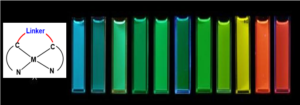
(1) Molecular phosphorescent materials design
Through this systematic color tuning, phosphorescent materials emitting from the near UV to the infrared have been developed for square planar Pt(II) and Pd(II) complexes. Especially, we have put in a greater effort to develop the blue region material due to accessible metal centered states for high energy excitons. Furthermore, in order to avoid some adverse effects that the two bidentate ligands may be capable of twisting out of plane upon excitation and relaxation lowering the quantum yields and stability. We have changed the concept of molecular design and replaced of the bidentate ligands double with the tridentate and tetradentate analogs in Pt(II) and Pd(II) complexes.

(2) Efficient and high color quality blue emitters
Blue phosphorescent materials and their devices have demonstrated much less success with each performance metric (color, efficiency, and stability) being progressively more challenging. We have achieved any available deep blue emission phosphorescent complexes at room temperature with long operational lifetimes by several strategies. There are: the adoption of ligands using N-heterocyclic carbenes, the use of rigid tetradentate ligands, and the recent emergence of promising photophysical attributes, namely, narrow band emitters and thermally activated delayed fluorescence from phosphorescent metal complexes.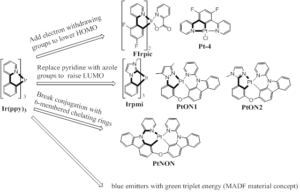
(3) Single doped white OLEDs
With judiciously designed emitters, we have designed and taken advantage of the blue emission from individual molecules and alongside broad yellow to red emission from excimers, resulting in a white light generation based on a single emissive material. Meanwhile, we have obtained the Single doped white OLEDs through the control of the dopant concentration, appropriate selection of host materials, and deposition conditions.
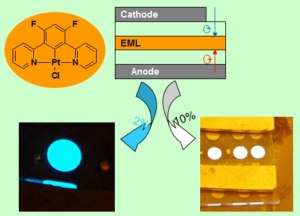
(4) Higher stability phosphorescent materials with long operational lifetimes
From the point of view of material design, we have optimized some phosphors with high radiative decay rates, stable redox properties, and stable excitation and relaxation. Based on this, we have also carried out a lot of experiments on the design and fabrication process of the devices. We have obtained excellent results through the optimization of the materials and the adjustment of the device structures.

- Solar Energy Materials & Solar Cells
The photovoltaic cells have the potential to provide low-cost solar-energy conversion owing to their relative ease of processing and compatibility with flexible substrates. Many research works have been done in different classification solar cells such as organic photovoltaic, dye-sensitized solar cell (DSC), bulk heterojunction organic solar cells (BHJ), quantum dot solar cell and perovskite solar cell so on.
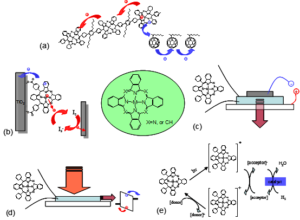
- Flex-Bio Array Technology Demonstrators
To combine the flexible color AM-OLED display technology and the flexible digital X-ray imager technology, we would take advantage of our phosphors and extend their applications in three aspects: point-of-care optical biosensors to diagnose multiple diseases and detect pathogens; wearable photoplethysmograph (PPG) sensor patch for precision cardiac monitoring; OLED-based optogenetic nerve stimulator to treat mental health disorders and inflammatory diseases.
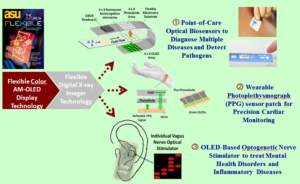
- Light-activated catalyst for organic reactions
The interaction between an electronically excited photocatalyst and an organic molecule can result in the genertion of a diverse array of reactive intermediates that can be manipulated in a variety of ways to result in synthetically useful bond constructions. We would utilize some metal complexes (Ir (III), Pt(II) or Pd(II) complexes )we have synthesized to catalyze some chemical reactions.
